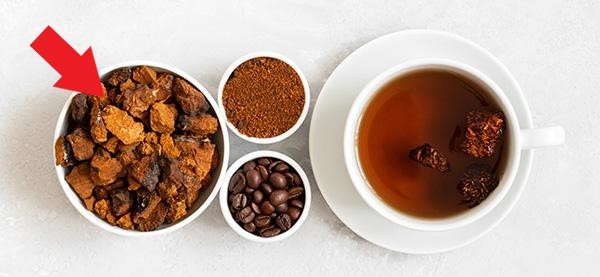
Better Than Espresso: Chaga Mushroom Coffee
When you mention mushrooms, most people picture a delicate, soft mushroom with a typical cap and maybe some gills. But chaga mushroom (Inonotus obliquus) is not your typical mushroom, so much so, that its classification is still debated by botanists. It’s easiest to describe it as a woody bracket fungus that looks like a burl on a tree.
Some people use it as a tea, a coffee substitute, or add it to their coffee blend. I think it tastes similar to Chinese oolong tea; bitter with a taste of charcoal, but refreshing.
Chaga Mushroom Benefits
It is a well-known anti-oxidant and research on mice shows promising anti-tumor properties.
Some people use it for stress relief and for boosting the immune system due to the high beta-glucan and polysaccharide content, but it also has a high oxalate content, so those prone to kidney stones and gout should avoid Chaga mushroom.
Chaga Mushroom Identification
It’s tough, black, and woody on the outside with a surface like burnt, cracked bark, but on the inside, it’s golden-brown colored, sometimes with white specks. The inside is only slightly softer than the tough exterior.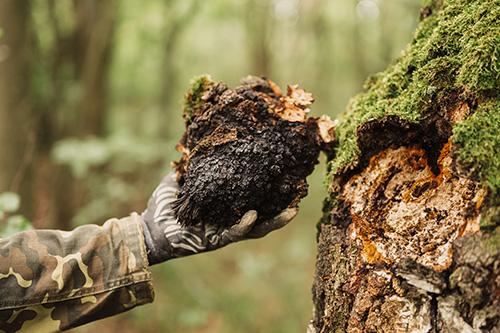
It can look similar to burls or other woody bracket fungus that grow all over the world, but fortunately for novice harvesters, identifying it is made easier by the fact that only the Chaga mushrooms found specifically on birch trees (Betula spp) produce the huge array of phytosterols which give it it’s medicinal properties.
When To Harvest Chaga Mushrooms
Fall or winter are the best seasons, ideally, after 2 weeks of cold overnight temperatures (minimum 41 °F or 5 °C) after which the birch trees become dormant. Spring and summer should be avoided since the sap from the birch tree is increasing and the Chaga is thought to be less potent.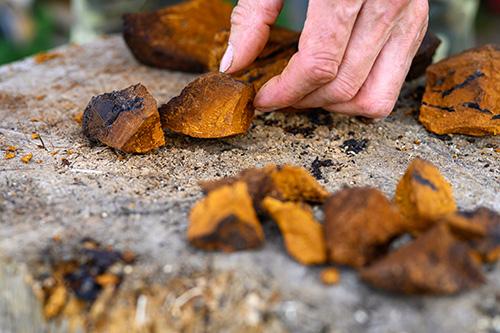
The first thing you need to find is a living birch tree; it must be living otherwise the chaga will also be dead, so look for the small, dormant winter buds to check that the tree is alive. Inspect the surface of the trunk for the tell-tale black, woody growths which are the Chaga mushrooms.
As with all wild foraging, harvest less than 20% of what you find, avoid any smaller specimens and leave a few large ones intact to ensure a future supply. An ideal, sustainable size is about the size of a grapefruit.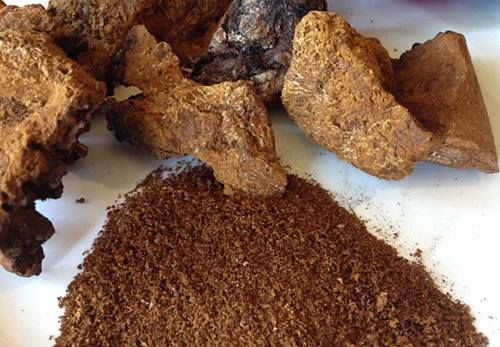
The method of removing the Chaga varies from person to person, but many people believe prying or “popping” the mushroom off avoids potentially cutting into the tree itself and damaging it.
Breaking it up into smaller pieces at this stage will be easier than once you get back home, and it will kick start the drying process.
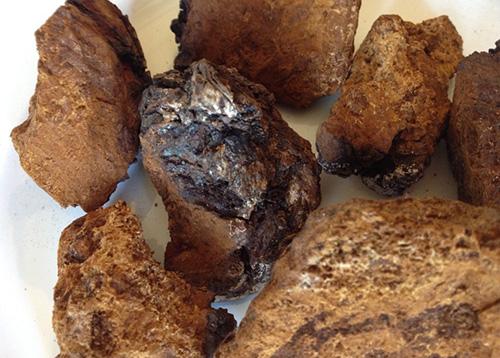
Just like when collecting other mushrooms, carry your harvest in a basket, never in plastic.
Processing Your Chaga Mushroom
Bust it up into smaller chunks, about the size of a grape, and allow the Chaga to dry in the sun for up to a week (unlikely in winter and fall…) or in a dehydrator for 1 – 2 days. As long as the temperature is less than 122 °F (50 °C) then you can even use your regular oven with the door open.
You can either use the dried chunks as is or grind them into a powder-like you would with coffee beans.
Store it in an air-tight container in your cupboard until needed.
How To Extract Chaga Mushroom
Many of its beneficial phytosterols such as beta-glucans and triterpenoids are contained within the indigestible chitin. High temperatures are needed to break down this chitin, which is why the traditional way of boiling it in water for at least 2 hours is also the simplest, and up to 35% of the phytosterols can be extracted this way. If you are brewing Chaga chunks, then they can be used for several brews. The ideal conditions for hot water extraction are 250 °F at 16 psi (121 °C at 1.1 kg/cm2) for 2 hours so some people use a pressure cooker.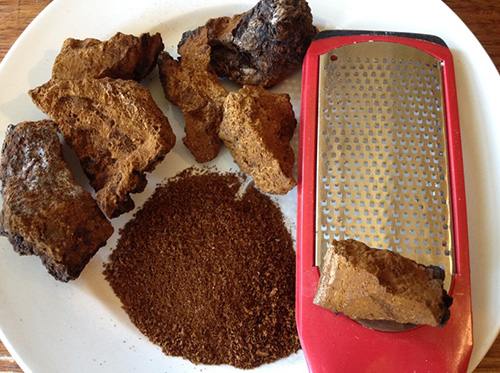
Once you have brewed your strong Chaga tea, there is one more use for your Chaga; a tincture. Now that you have used high temperatures to break down some of the chitin, the alcohol-soluble compounds are more readily extracted in room-temperature alcohol. Allow your Chaga to re-dry for a day or two and pop it into some alcohol (at least 40% but the higher the better in this case). Leave it at room temperature for 2 weeks, strain away the Chaga and you now have an alcohol-based Chaga tincture ready to use throughout the year.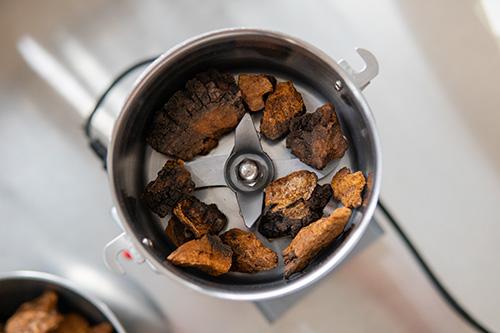
Another interesting way to break down the chitin is by using the naturally occurring chitinase enzymes found in mature chestnut seeds, and since fall is also the time to harvest chestnuts, then it is easy to prepare the chestnut in the same manner as the Chaga: Dry then boil and/or grind with your Chaga and coffee. Just don’t roast either your Chaga or your chestnuts since roasting temperatures are too high and are likely to destroy many of the medicinal compounds.
Chaga Mushroom Recipes
There are a few different ways to consume your Chaga mushrooms;
- Play around with grinding your coffee beans with Chaga at a ratio that suits your taste and prepare just as you would your regular coffee. This is the least potent method since the brewing time is quite short, but it is also the most convenient.

- Boil 4 teaspoons of Chaga in about 14 oz (400 ml) of water for 2 hours to turn it into a strong tea. You can either drink this strong tea as is, add some milk and sugar, or use the tea as a substitute for water in your normal coffee routine.

- Try an Irish coffee by infusing the boiled chaga in alcohol for 2 weeks to make a tincture. Then you can add a dropper or two of the tincture to the chaga tea and/or add some coffee as well. This dual method is the most potent since it extracts both the water and alcohol soluble compounds.
- Add some chestnut to any of the recipes above to help break down the chitin and add a different flavor.
Whichever way you try it, Chaga mushroom can change your coffee or tea routine at the same time as providing some stress relief and health benefits. And even though it takes much longer to brew than a quick cup, fall and winter are the perfect time to let it boil away on the stovetop or over the fire.
You may also like:
The $200 A Pound Mushroom You Should Forage For Profit
Add This “Unusual Nutrient” to Coffee or Tea, to Effortlessly and Fully Empty Your Bowels Every Single Morning (Learn More)








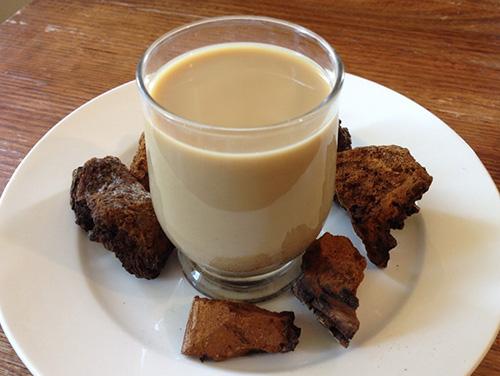
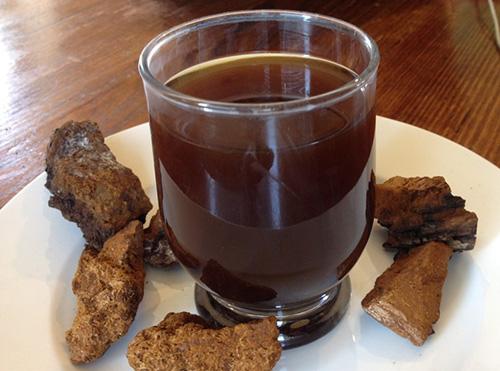
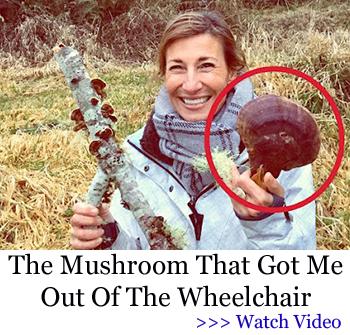

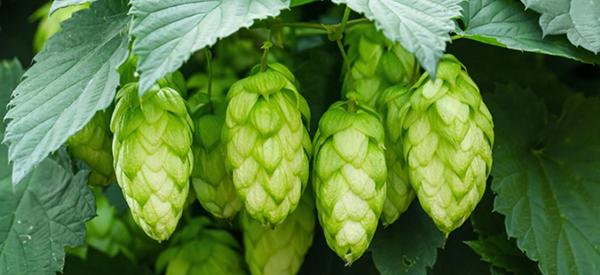

Do you actually think I am stupid enough to put a bitter tasting mushroom in my coffee?
Probably don’t put lemon in your tea either. It would probably make it taste bitter too. But if perchance you change your mind… get chaga here: https://amzn.to/3aWEk6k
Once you brew the tea from the conk (Chaga) or the ground chaga you won’t have bitter George, you will have medicine instead of just a cup of acid (coffee).
You might like it 🙂
You can lead a horse to water, but you can’t make it drink! . . . 🙂
Agreed however a medicine like product cannot replace an indulging product such a coffee in terms of replacing consumption habits. So I get George’s point but I also understand Nicole’s well intended friendly advice.
Chaga is NOT bitter, tastes lika a blend of vanilla and moss, an” earthy” tadte, not bitter!!!
If you want the health benefit yes
I do believe the chaga is beneficial as there is more information on it and other fungi . . In reference to the “cup of acid” comment, there are many drinks that are acidic with health benefits. Coffee is one of them.
I have been drinking mushroom coffee for over a year. The taste is phenomenal and I am a coffee drinker. Don’t knock what you haven’t tried
When you say to boil 4 teaspoons – this would be ground changa?
Thanks for asking this question Christina, I was wondering the same thing!
Yes, this would be ground chaga or very small pieces that are smashed with a hammer to break them up. You can put an old towel over the pieces before you smash them to keep pieces from flying out and hitting something or someone. Also, 3 teaspoons equal one tablespoon, so if it’s easier you could just use one slightly rounded tablespoon instead of 4 teaspoons. 🙂
Double extractions are recommended. You do this first by extracting in water. Then in alcohol, then combining the two extractions. This will allow all of the medicinal properties to be obtained. You can do all of this indicated here…OR just buy chaga coffee: one company is Four Sigmatic…they blend mushrooms with coffee…they are spendy, but the coffee is pretty good…I have purchased them in the past, but they are a bit too expensive for me. I do buy the packets and use occasionally. They also have chocolate/mushroom blends
Chaga Tea cured a lady that had cancer. She told me that she was tired of the chemo and radiation that made her so sick. She has been cancer free for quite a years and teaches about herbs herself. She works for one of the Uhiversaties in Maine.
Upon reading about Adaptogens, it is said might not be recommended for Diabetics. Would the mushrooms, Chaga or others be in the same warning zones as Ashwagandha?
I know this is an older post, I do have chaga and am excited to add this amazing mushroom. However I have osteoporosis and have read that chaga mushroom should not be ingested as it leaches minerals from your bones, I am unsure about this and would love some clarification please.
Thank you so much for your great resource I read every single blog… Nuggets of gold 🙂
I drink Chaga Chai tea all the time and I love it!!!